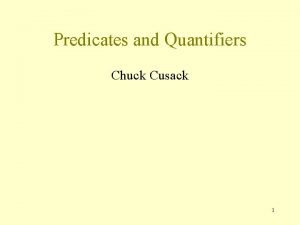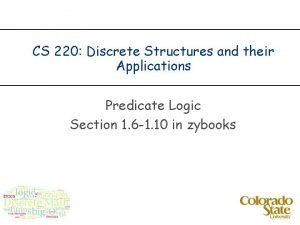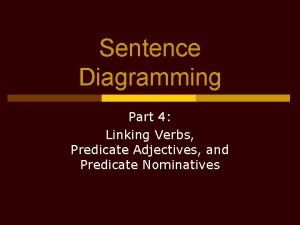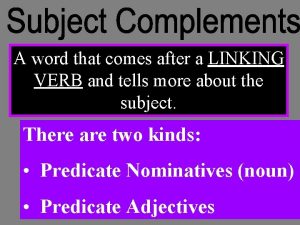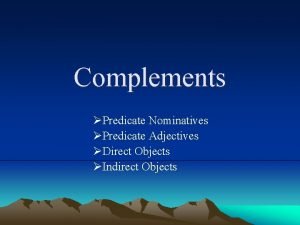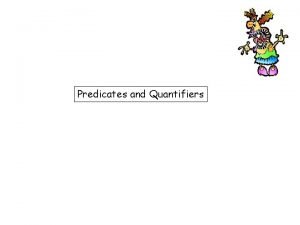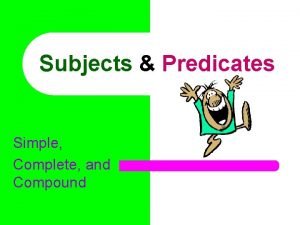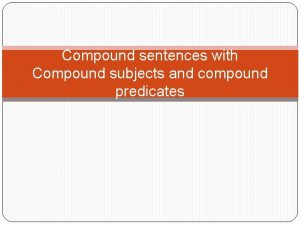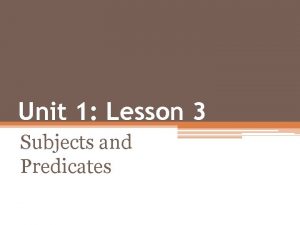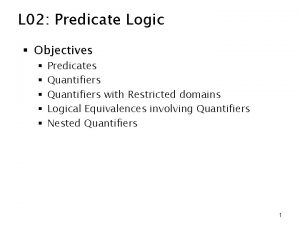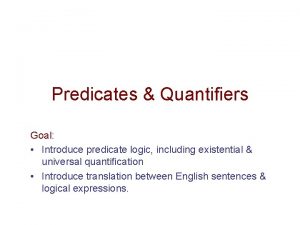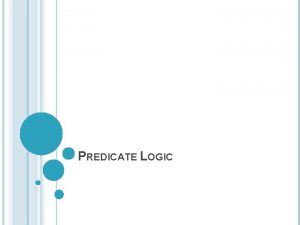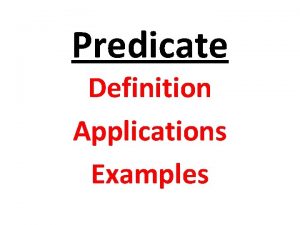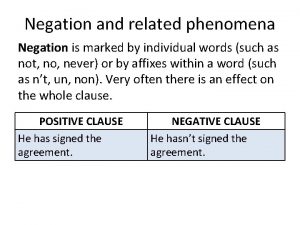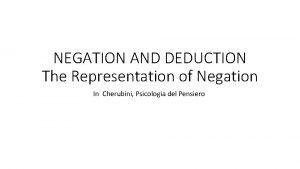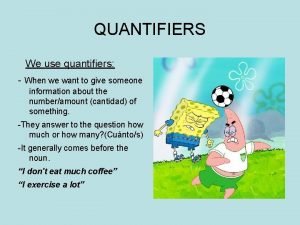Quantifiers and Negation Predicates Predicate Will define function

















- Slides: 17

Quantifiers and Negation Predicates

Predicate • Will define function. • The domain of a function is the set from which possible values may be chosen for the argument of the function. • A predicate is a function whose possible values are True and False.

Universal Quantifier • The universal quantifier. • Upside down A. • “For All”

Universal Quantifier • Let P(x) be a predicate with domain D. • A universal statement is a statement in the form “ x, P(x)”. It is true iff P(x) is true for all x in D. It is false iff P(x) is false for at least one x in D. • A value of x which shows that P(x) is false is called a counterexample to the universal statement.

Universal Quantifier Examples • Let D = {1, 2, 3, 4, 5}. x, x² >= x • Let D=Reals. x Reals, x² >= x • Let D= Natural numbers. Let P(x)=x is prime, E(x)=x is even. x E(x) x P(x) x (E(x) V E(x+1))

Existential Quantifier • Existential quantifier. • Backwards E. • There Exists

Existential Quantifier • Let P(x) be a predicate with domain D. • An existential statement is a statement in the form “ x, P(x)”. It is true iff P(x) is true for at least one x in D. It is false iff P(x) is false for all x in D. • Examples: D=Integers, m, m² = m D = {5, 6, 7, 8, 9}, m, m² = m

Universal Conditional Statement • Universal conditional statement x, (P(x) Q(x)) Example: D=Reals. x, (x > 2 x 2 > 4) • A universal conditional statement is vacuously true or true by default iff P(x) is false for every x in D. i. e. ~ x D, P(x) iff x D (P(x) Q(x)) is vacuously true.

Universal Conditional Statement Examples: D=Natural numbers. E(x)=x is even. P(x)=x is prime x (E(x) ~E(x+1)) x ((E(x) Λ x > 2) ~P(x)) x (P(x) ~E(x))

Negation of Quantified Statements • ~ ( x D, P(x)) ≡ x D, ~P(x) • ~( x D, P(x)) ≡ x D, ~P(x) • ~ x D, P(x) Q(x) ≡ x D, ~(P(x) Q(x)) ≡ x D, P(x) ~Q(x)

Multiply Quantified Statements • Let the D=Integers. Let P(x, y) = y<x. • There exists a number x, there exists a number y, such that y<x x, y, P(x, y) ≡ y, x, P(x, y) True (both True) • For all numbers x, for all numbers y, y < x x, y, P(x, y) ≡ y, x, P(x, y) True (both False)

Multiply Quantified Statements • For all numbers x, there exists a number y such that x < y x, y, P(x, y) True • There exists a number y such that for all numbers x, x < y y, x, P(x, y) False • x, y, P(x, y) ≡ y, x, P(x, y) False

Negation of Multiply Quantified Statements • • ~ x, y, P(x, y) ≡ x, y, ~P(x, y)

Example a) Symbolize: The sum of any two even integers is even. b) Negate it.

Example Solution • Let E(x)=“x is even”. • Let E(x, y)=“x+y is even”. • Let the domain be the Integers. a) x, y, E(x)^E(y) E(x, y) b) x, y, E(x) ^ E(y) ^ ~E(x, y)

Which of the following is true? x D, (P(x) Q(x)) ≡ ( x D, P(x)) ( x D, Q(x))

, , Λ, ν Let P(x) be a predicate. Let D={x 1, x 2, …, xn} be the domain of x. • x D, P(x)≡P(x 1) Λ P(x 2)Λ…ΛP(xn) • x D, P(x) ≡P(x 1) ν P(x 2)ν…νP(xn)
 Predicates and quantifiers examples
Predicates and quantifiers examples Applications of predicates and quantifiers
Applications of predicates and quantifiers Predicate negation
Predicate negation Predicate nominative and predicate adjective
Predicate nominative and predicate adjective Predicate nouns and predicate adjectives
Predicate nouns and predicate adjectives Predicate nominative and adjective
Predicate nominative and adjective How to diagram a predicate nominative
How to diagram a predicate nominative Predicate nominative
Predicate nominative Predicate nominative and predicate adjective
Predicate nominative and predicate adjective Simple vs complete predicate
Simple vs complete predicate Negation paragraph examples
Negation paragraph examples How a predicate function become a propositional function?
How a predicate function become a propositional function? Simple subject vs complete subject
Simple subject vs complete subject Complete and simple predicate
Complete and simple predicate Lesson 4 subjects and predicates simple and complete
Lesson 4 subjects and predicates simple and complete Double predicate example
Double predicate example Draw a line between the complete subject and predicate
Draw a line between the complete subject and predicate He pooled popcorn dipped in ketchup
He pooled popcorn dipped in ketchup
